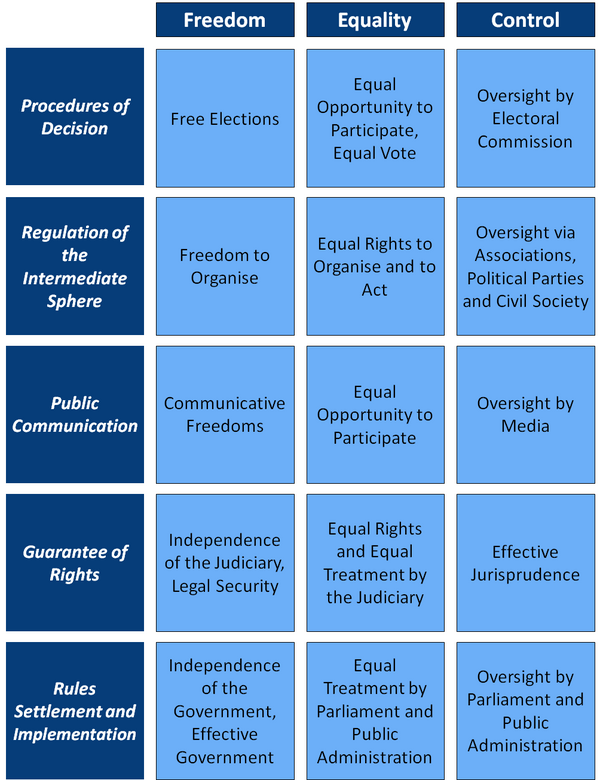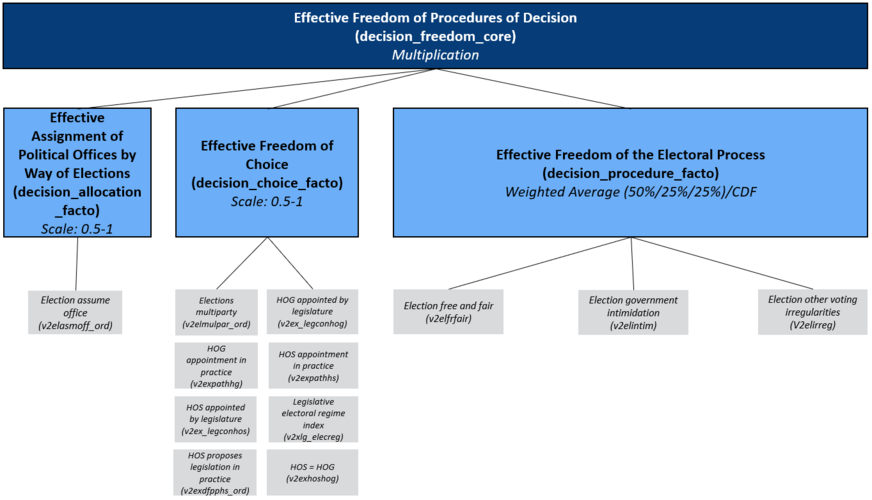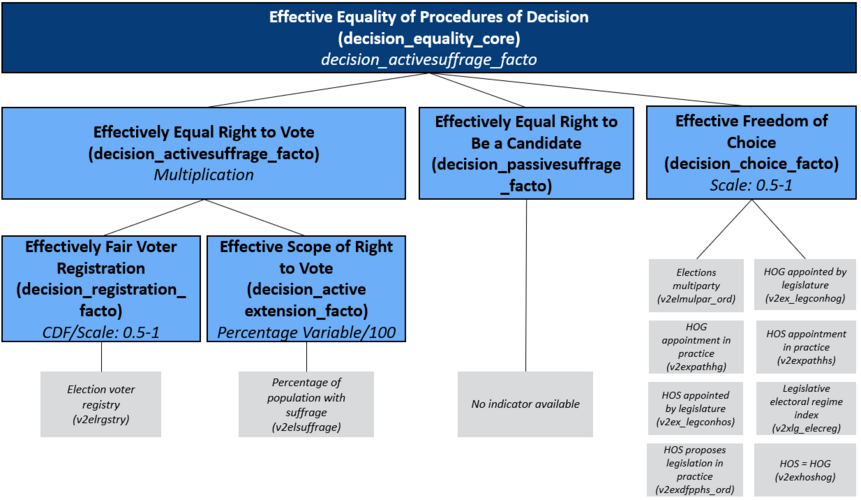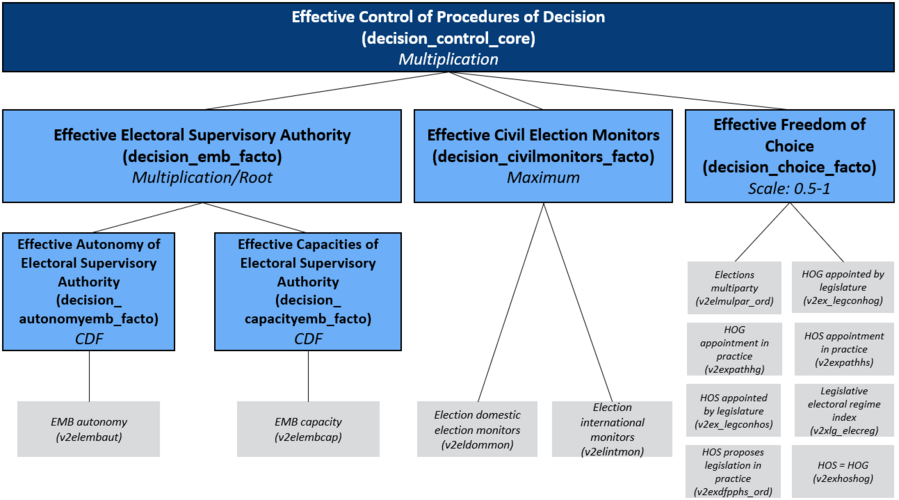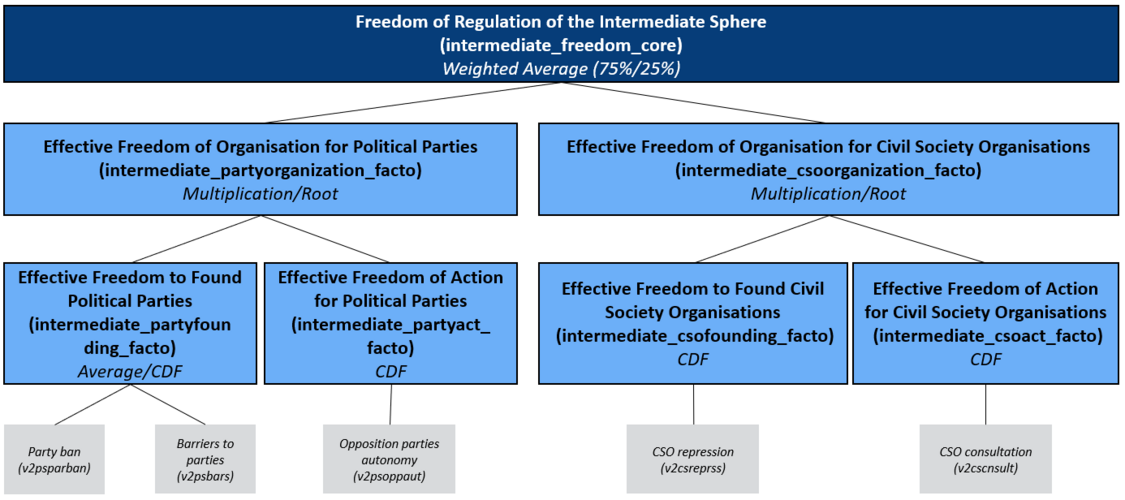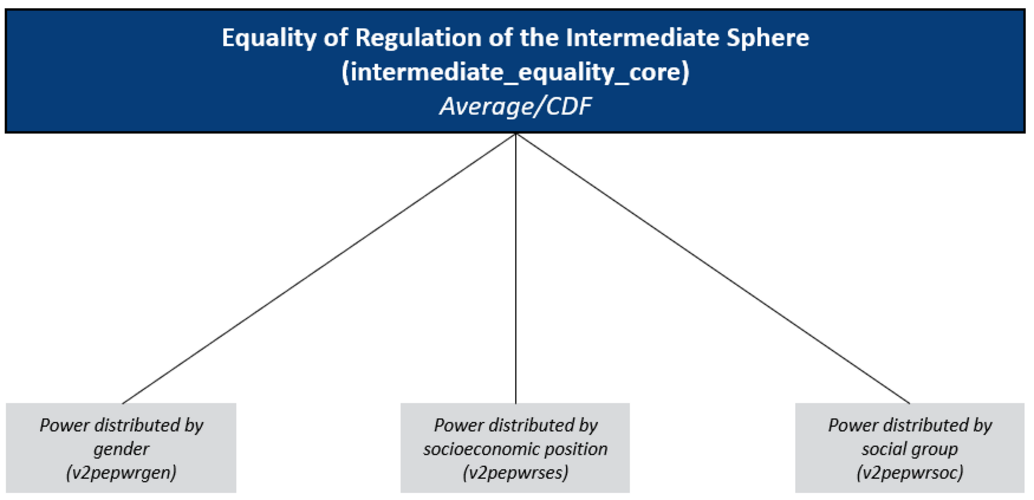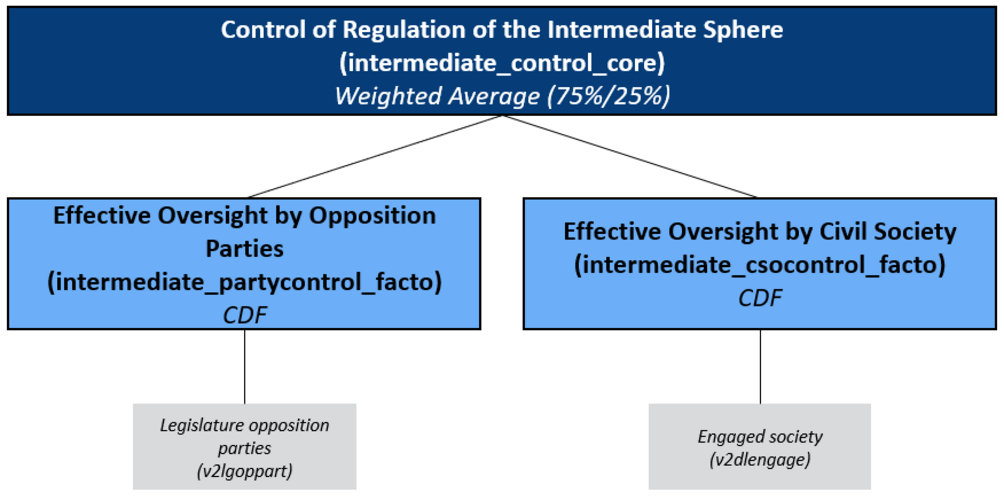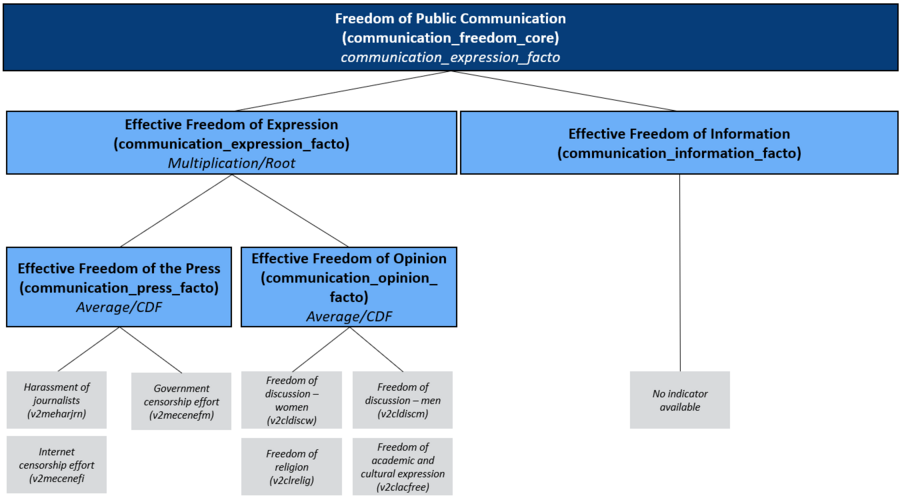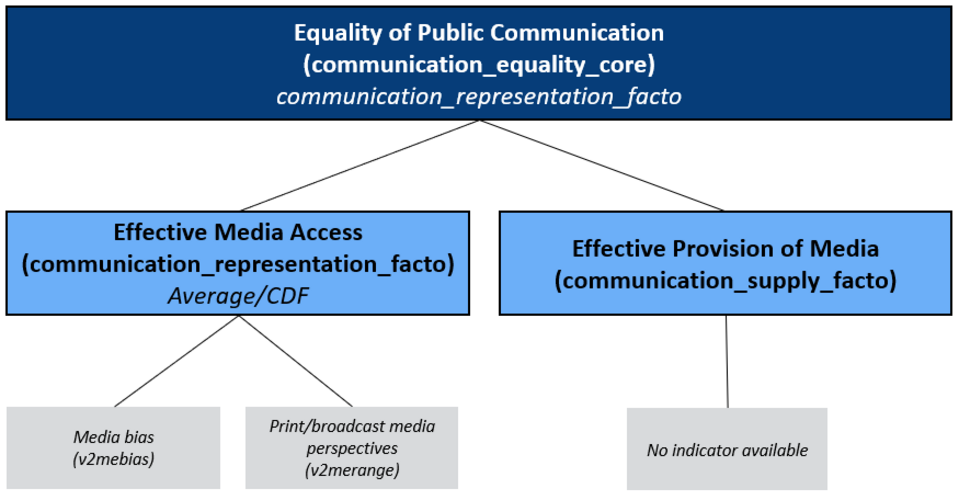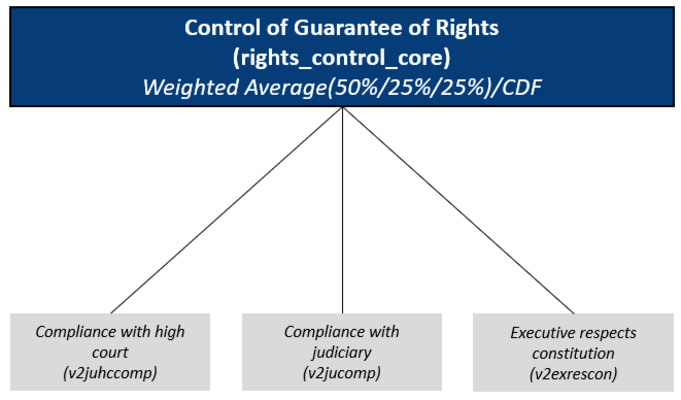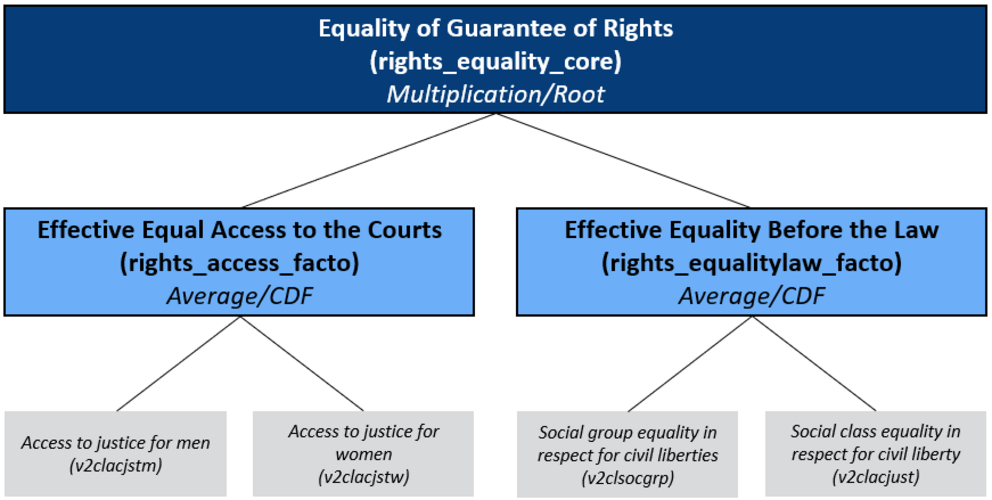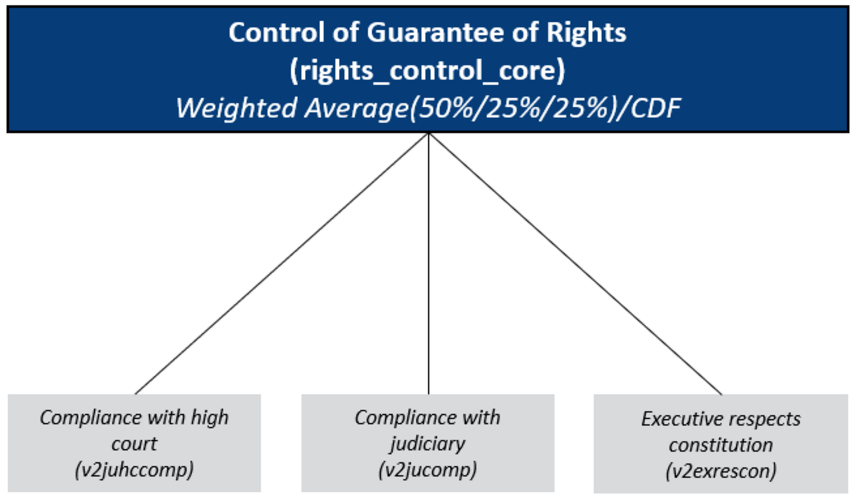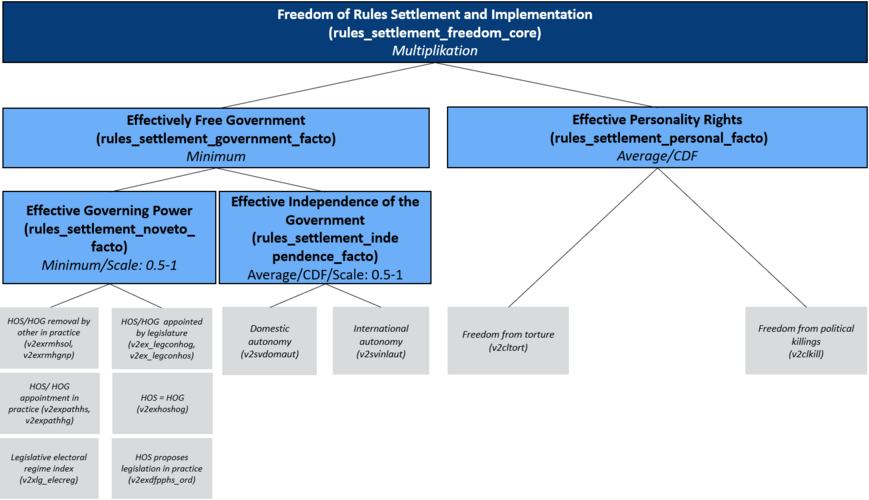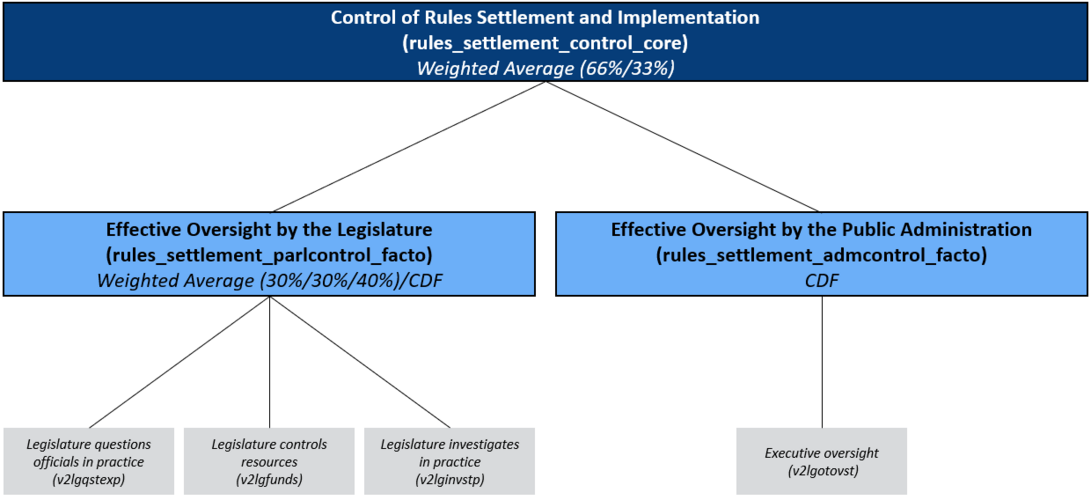Core measurement is the first measurement level of the democracy matrix and therefore represents the point of departure for measuring the democracy quality of a country. It covers the functioning of key democratic institutions. For each matrix field, we have created a detailed concept tree, which displays both the individual relevant subcomponents and the indicators selected from the V-Dem dataset for the purpose of operationalisation. The aggregation rules applied are found here.
Freedom of Procedures of Decision
Free procedures of decision aim, in particular, at national elections. For national elections to be classified as free, three necessary and together sufficient conditions must apply: Firstly, by way of an election in the sense of an effective election, political offices must be assigned, in the sense that the winner of an election can in fact assume his or her office. Secondly, effective freedom of choice must be present, so that citizens can choose from different parties in the election and select the relevant positions in government and parliament. Finally, there must be a free electoral process, so that no manipulation of the elections arises.
V-Dem indicators used: v2elasmoff, v2elirreg, v2elintim, v2elfrfair, v2elmulpar, v2ex_legconhog, v2expathhg, v2expathhs, v2ex_legconhos, v2xlg_elecreg, v2exdfpphs_ord, v2exhoshog
Aggregation rules applied: CDF, weighted average and multiplication
Equality of Procedures of Decision
Equal procedures of decision aim, in particular, at the national level. Equal national elections are the result of the scope of voting rights, both the right to vote and the right to stand as candidate (both necessary and, taken together, sufficient conditions): An election in which the majority of the population has the right to vote, but not the right to be a candidate, is not democratic. An effectively equal right to vote is constituted from an effective and thereby error-free voter registration and the possibility to exercise the right to vote unimpeded. Both are again necessary and, taken together, sufficient conditions. Finally, in order to be able to speak of an election, there must be effective freedom of choice, so that citizens can choose from different parties in the election and select the relevant decision-making positions in government and parliament.
V-Dem indicators used: v2elrgstry, v2elsuffrage, v2elmulpar, v2ex_legconhog, v2expathhg, v2expathhs, v2ex_legconhos, v2xlg_elecreg, v2exdfpphs_ord, v2exhoshog
Aggregation rules applied: CDF, multiplication
Control of Procedures of Decision
Control of the procedures of decision can, on the one hand, take place by way of an effective election verification commission or by way of election monitors from civil society. Indeed, both are necessary conditions for effective election oversight; however, every actor is itself a sufficient condition (i.e. election verification by one actor is, as a rule, sufficient, whereby an effective election verification commission can better exercise control over elections and hence must be given greater weight). For an election verification commission to be effective, its autonomy from the government must be assured and, at the same time, it must be provided sufficient capacity. An election verification commission with sufficient capacity, but that lacks autonomy cannot fulfil its democratic function. Both are, therefore, necessary conditions and together sufficient conditions. Finally, in order to be able to speak of an election, there must be effective freedom of choice, so that citizens can choose from different parties in the election and select the relevant decision-making positions in government and parliament.
V-Dem indicators used: v2elembaut, v2elembcap, v2eldommon, v2elintmon, v2elmulpar, v2ex_legconhog, v2expathhg, v2expathhs, v2ex_legconhos, v2xlg_elecreg, v2exdfpphs_ord, v2exhoshog
Aggregation rules applied: CDF, multiplication/root, multiplication and maximum
Freedom of Regulation of the Intermediate Sphere
Free regulation of the intermediate sphere is characterised by freedom of organisation for political parties and also for civil society (trade unions and associations, social movements, citizens’ initiatives). Since political parties represent the central form of organisation in democracies, parties are given greater weight vis-à-vis civil society. In the case of both sorts of organisation, freedom of organisation is based on not being exposed to hindrances either in the founding of the organisation or in the pursuit of each organisation’s respective goals (except in the case of extremist parties or organisations). Both elements are necessary and, taken together, sufficient conditions, which are given equal weight: parties and civil society organisations that are founded, but cannot pursue their goals, merely represent alibi functions for the regime; they cannot, however, fulfil their democratic function.
V-Dem indicators used: v2psparban, v2psbars, v2psoppaut, v2csreprss, v2cscnsult
Aggregation rules applied: Average, CDF, multiplication/root, weighted average
Equality of Regulation of the Intermediate Sphere
Equal intermediation exists when there is equality of opportunity for political parties and for civil society (trade unions and associations, social movements, citizens’ initiatives). Equality of opportunity for political parties or civil society organisations is realised when sufficient organisational capacity is made possible for all relevant interests within a society (social classes, social groups) and, on the other hand, equal action possibilities exist, in the sense that these interests are equally taken into account in the policy decisions that concern them.
Unfortunately, this matrix field can only be measured using proxy indicators that target the equal distribution of political influence between socio-economic, social and gender groups.
Control of Regulation of the Intermediate Sphere
Control via intermediation takes place both by way of opposition parties and by way of civil society (trade unions and associations, social movements, citizen’s initiatives). To a certain extent, civil society can here substitute for the oversight functions of weak opposition parties; but as a key democratic organ, oversight by parties is assessed as having greater weight. On the other hand, a regime that includes strong opposition parties with, at the same time, weak civil society can by all means still be regarded as democratic – but even in this case, a minimum amount of civil society must be present.
Freedom of Public Communication
Public communication is free, if both free expression of opinions takes place and there is also a sufficient transparency of the political process. Freedom of information in the sense of the transparency of the political process is important, but the key component is the possibility of expressing one’s opinion. Freedom of expression is devalued, however, when the political process is highly untransparent. Therefore, both are necessary and together sufficient conditions, even if freedom of expression is given greater weight. Freedom of expression is based on freedom of the press (prohibition of censorship) and freedom of opinion, which comprises both the public and the scientific spheres, as well as freedom of religion. Both, freedom of the press and freedom of opinion, are necessary and together sufficient conditions. Since no indicator was available for the transparency of the political process, this field could only be calculated by way of the values for freedom of expression.
V-Dem indicators used: v2mecenefm, v2meharjrn, v2mecenefi, v2cldiscw, v2cldiscm, v2clrelig, v2clacfree
Aggregation rules applied: CDF, average, multiplication/root
Equality of Public Communication
The equality of the institution of public communication is constituted by the equal provision of media to citizens and an equal access to the media for all relevant interests (both necessary and together sufficient conditions). For the equal provision of media only increases democracy quality, if citizens are provided with media that portray a wide spectrum of opinions. Unfortunately, the Varieties-of-Democracy dataset does not presently contain any indicator for the equal provision of media to citizens.
Freedom of Guarantee of Rights
Free guarantee of rights in the form of the rule of law is comprised of a judicial apparatus (courts and constitutional court) that has political independence, as well as of the prevalence of legal security. Both are necessary and together sufficient conditions for this matrix field.
V-Dem indicators used: v2juhcind, v2juncind, v2cltrnslw, v2juaccnt
Aggregation rules applied: CDF, weighted average, multiplication/root
Equality of Guarantee of Rights
Equal guarantee of rights means both equal access to the courts and equality before the law, which represent important elements of the rule of law. The latter includes equality between social groups and socio-economic classes. Equal access to the courts and equality before the law are necessary and sufficient conditions.
V-Dem indicators used: v2clacjstm, v2clacjstw, v2clsocgrp, v2clacjust
Aggregation rules applied: CDF, average, multiplication
Control of Guarantee of Rights
The control function within guarantee of rights means effectiveness and enforceability of jurisprudence. This is characterised by the extent to which the government is oriented by court rulings and thus respects them. Here, courts and – if present – constitutional courts are the focus.
V-Dem indicators used: v2juhccomp, v2jucomp, v2exrescon
Aggregation rules applied: weighted average, CDF
Freedom of Rules Settlement and Implementation
Free rules settlement and implementation is the result, on the one hand, of the possession of governing power in the sense of an effectively free government, as well as of the respect of personal rights by the government. Both are necessary and together sufficient conditions. Effective governing power requires, on the one hand, that there are not any non-democratic veto players within the political system, which can block the decisions of the elected officials. On the other hand, the government must be effectively independent of other states. The government is, in turn, understood as the representative of free citizens. In order for this to be the case, the government itself may not violate freedom, in the sense of respecting personality rights.
V-Dem indicators used: v2exrmhsol, v2exrmhgnp, v2ex_legconhog, v2expathhg, v2expathhs, v2ex_legconhos, v2xlg_elecreg, v2exdfpphs_ord, v2exhoshog,v2svdomaut, v2svinlaut, v2cltort, v2clkill
Aggregation rules applied: minimum, CDF, average, multiplication
Equality of Rules Settlement and Implementation
Equality in rules settlement and implementation is comprised of equal treatment by the parliament and equal treatment by the executive. Both are necessary and together sufficient conditions. Equal treatment by parliament means equal functional representation of interests in parliament. Finally, equal treatment by the executive comprises a public administration that is impartial and does not discriminate.
Control of Rules Settlement and Implementation
The control function within the institution of rules settlement and implementation takes place, on the one hand, by way of the parliament itself and, on the other hand, by way of the public administration (e.g. ombudsman or court of auditors). Given the more important position of the institution in the political system, parliamentary oversight rights are given greater weight.


